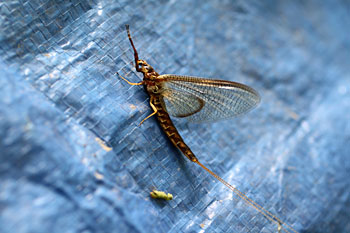Figuring Out the Local Hatch
Have a question you want answered? Email it to us at [email protected].
Question: My job involves lots of road travel, and I always keep my fishing gear with me so I can pull over and fish streams that look trouty. But my territory covers almost a quarter of the country, so I’m not always familiar with local hatches. Is there a quick way to get a sense of what bugs I should be imitating on an unfamiliar stream?
Kyle H., North Braddock, PA
Answer: I assume that we’re talking about dry flies here. Obviously, if you see any bugs on the water, all you have to do is collect a few and then tie on a matching pattern. But, as we all know, you can’t count on duns floating by at all times. In these situations, you have to look elsewhere. Where, You ask?
Start with streamside vegetation. Most species of aquatic insects stick close to home in the time between hatching and when they return as spinners or ovipositors. Shake some bushes and see what flies out. Sometimes, the insects will be quite evident, clustered on blades of grass and bushes.
Next, inspect the surface of any eddies, sloughs, or floating foam to see what has collected there. Stillborn duns or last night’s spinners might still be visible.
Other great places to find evidence include streamside spider webs, the screens of nearby buildings, and even the front grilles of the cars in the parking lot at the fishing access. Even a smashed mayfly can offer clues to what size and color you should use. If stoneflies are hatching, you’ll find their shucks on the rocks in the stream itself. If you root around enough in these places, or anywhere else you’d expect bugs to congregate, you can get a good idea what hatched yesterday. And if it hatched yesterday, it’ll more than likely hatch again today.
There’s also a more high-tech approach, if you happen to have an iPhone. An app called “The Hatch 2” offers hatch-matching information on more than 300 rivers across the U.S.
Finally, you could swallow your pride and just ask another angler, if any are around. In our culture, this is often frowned upon, but it can be very effective. And most fly fishermen are perfectly willing to help a stranger.












